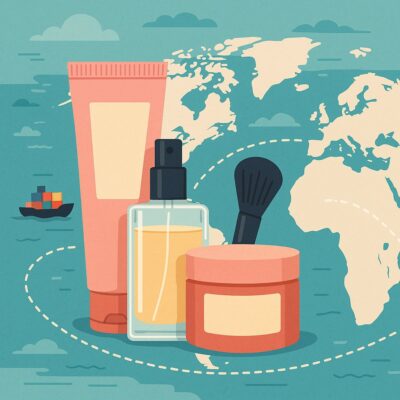
Source Beauty’s Maggie Spicer On The Competitive Advantages Of Sticking To Sustainability Amid Tariff Pressures
For beauty brands committed to sustainability, President Donald Trump’s tariffs are a huge test of the strength of that commitment. Source Beauty founder Maggie Spicer, a former trade attorney supporting sustainability and social impact in the beauty industry, argues they’ll benefit by not abandoning their commitment, even if it causes short-term pain.
She says she’s hearing from brands, “‘We don’t want to regress, but we are also overwhelmed by the tariffs. It’s not a papercut. I feel the hemorrhage already, what am I supposed to do?’ The brands that do make it through the tariffs are going to be set up for long-term success because the tariffs are going to force them to be very strategic: Who are we as a company, what are we selling, and who are we selling to? When the headwinds turn in those brands’ favor, it’s going to be fantastic.”
Spicer acknowledges that sustainability-oriented beauty brands have hard choices to consider to keep their businesses afloat amid skyrocketing costs due to tariffs, which are being levied at a 10% baseline on most countries and as much as 245% on goods imported from China. They may be vetting cheaper packaging and ingredients or slashing marketing related to sustainability messaging. Still, she views walking away from sustainability as a particularly risky move.
“When you lose a consumer trust and they see you having made sustainability commitments and pivoting, it’s hard to get that trust back,” says Spicer. “For the sustainability-focused consumer, they do not lower their expectations of brands. They are not going to say, ‘Oh, I know the market is tight right now, so I understand.’ They tend to be a discerning and high-demand customer.”
Below, Spicer identifies trade-offs she believes are wiser than eliminating eco-friendliness and advice for placing sustainability efforts in a broader business context.
remember larger company responsibilities Beyond Packaging And Ingredients.
“Some brands who treat sustainability as a surface-level thing are saying, ‘You know what, forget the sustainable packaging, just get whatever is cheaper,’” says Spicer. “Brands that have been doing sustainable packaging as part of extended producer responsibility, they are not looking at the tariffs in a vacuum. There are all these other issues that packaging is tied to. The ability to pull in the wider frame of reference is helping some brands think strategically as opposed to just chasing the lowest price and potentially that leading to longer term costs that the brands didn’t anticipate.”
Look at your transportation footprint.
Spicer counsels brands to locate cost-cutting measures that could have long-term business advantages that square with sustainability. She recounts a panicked brand client brought in a transportation consultant to examine its transportation costs and discovered a third of its shipments were being done on air freight. Shifting it to maritime lengthened lead times slightly, but cut costs in half and reduced emissions.
“When you are looking at your packaging PO, there are other levers you can pull that help with it,” says Spicer. “Ideally, you have built in processes that are better for the business and the planet that, if the tariff rates go back down, you will have embedded resiliency.” She continues, “Freight and logistics are the least sexy part of operations and frequently get overlooked, but making sure those teams are well supported can end up saving money.”

Tweak packaging rather than transform it.
Many brands’ actions on sustainability concentrate on packaging, and that’s an area they’re under pressure to change because most beauty packaging comes from tariff hotspot China. Spicer, who mentions wholesale changes to packaging could prohibit brands from entering clean retailers or clean programs at general merchandise retailers, asserts brands can stop short of doing a 180 on eco-conscious packaging by reducing customization and sizes.
She asks, “Can you work with your packaging supplier to find the same bottle and decorate it differently so everything doesn’t need to be massively customized? Pull on the creative teams to work on together parameters to be more efficient and better from a sustainability perspective.”
Be transparent about price increases connected to sustainability.
Brands are communicating extensively about price hikes related to tariffs. With those communications proliferating, Spicer senses consumers are receptive to brands’ explanations about price increases resulting from sustainability commitments. She says a brand could relay, “If we are going to maintain fair wages across our supply chain, this is what we have to do.” She adds, “I don’t think they should be sharing the specific ins and outs of the contracts they have with suppliers, but people are open to a more nuanced conversation than, ‘The prices went up, sorry.’”
Lean into sustainable merchandise as a good investment.
During economic downturns, Spicer buys a capsule wardrobe of a few staple items that are versatile and sturdy. Beauty brands can play into the capsule wardrobe philosophy. “This is the little black dress of your skincare, and you should have this even if everything else gets stripped away,” says Spicer. “It’s more than just luxury positioning, it’s performance driven—this has to work because I’m only buying this one.”
She elaborates, “Anything a brand can do that bolsters that differentiation on the market is going to solidify that positioning as the must-have purchase for you if you are trimming back. I always think of sustainability as something that serves that purpose because, if the consumer is going for price and performance, but is faced with three similar positioned products, the one that brought me in on the storytelling of what they are doing behind the scenes with sustainability is going to tip the scale if I’m a values-minded consumer.”
“For the sustainability-focused consumer, they do not lower their expectations of brands.”
Carefully cull assortments.
“Brands will go into the treasure chest and pull out the most valuable IP that customers already know and double down on that,” says Spicer. “They will focus innovation on the legacy products and the products that resonate with their consumers, and they might try not to do as many new products. We are still going to see innovation. It will be just innovation housed in existing product verticals.”
Be cautious about celebrating potential reductions in overconsumption.
Americans have much more stuff than people in other countries and considerably more than they had in decades past. Tariffs-fueled price hikes on consumer goods could help curb overconsumption by stunting consumers’ ability to purchase goods and lead to less emissions as they purchase less and a portion of manufacturing possibly transitions onshore. However, Spicer warns that the effects of tariffs on overconsumption are yet to be realized and championing it for the sake of the earth could ignore real issues consumers are facing as they contend with the tariffs.
“I tend to think some of that conversation is very pollyannaish because it ignores U.S. manufacturing capacity,” says Spicer. “If U.S. brands tried to onshore, we don’t have the physical infrastructure, access to resources and technical know-how. It will take years to build that up, but, even then, we would have higher costs.”





Leave a Reply
You must be logged in to post a comment.